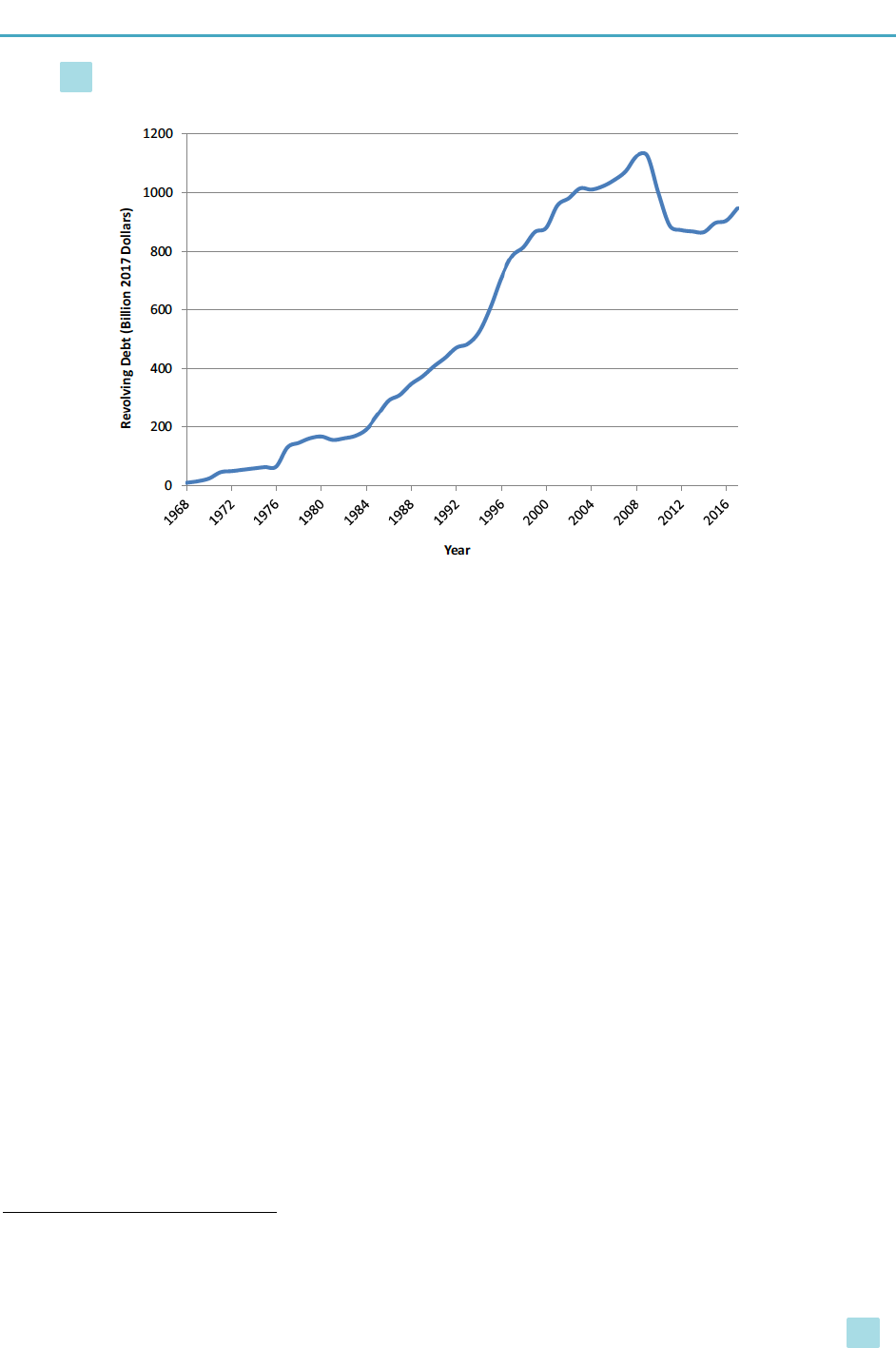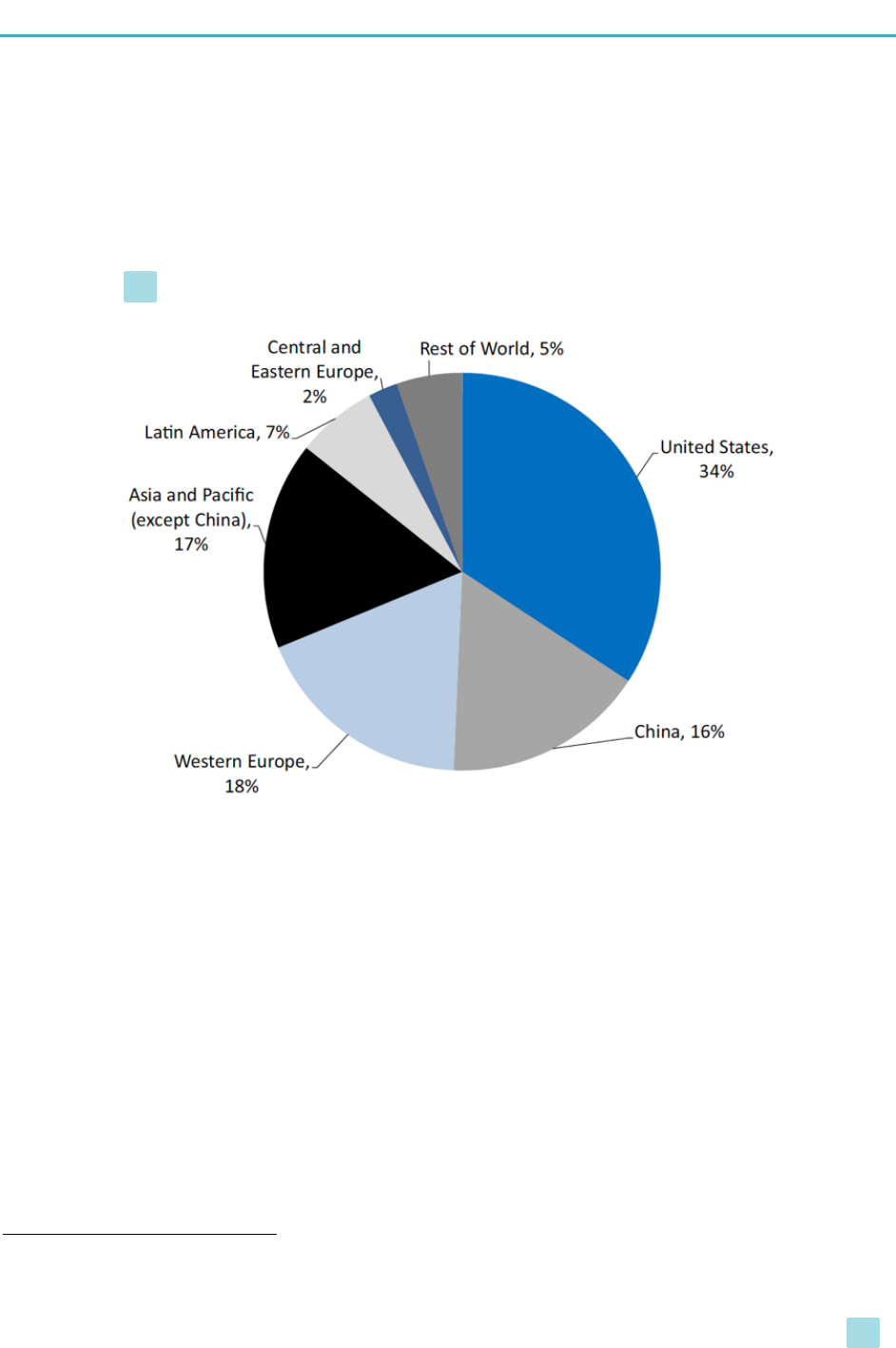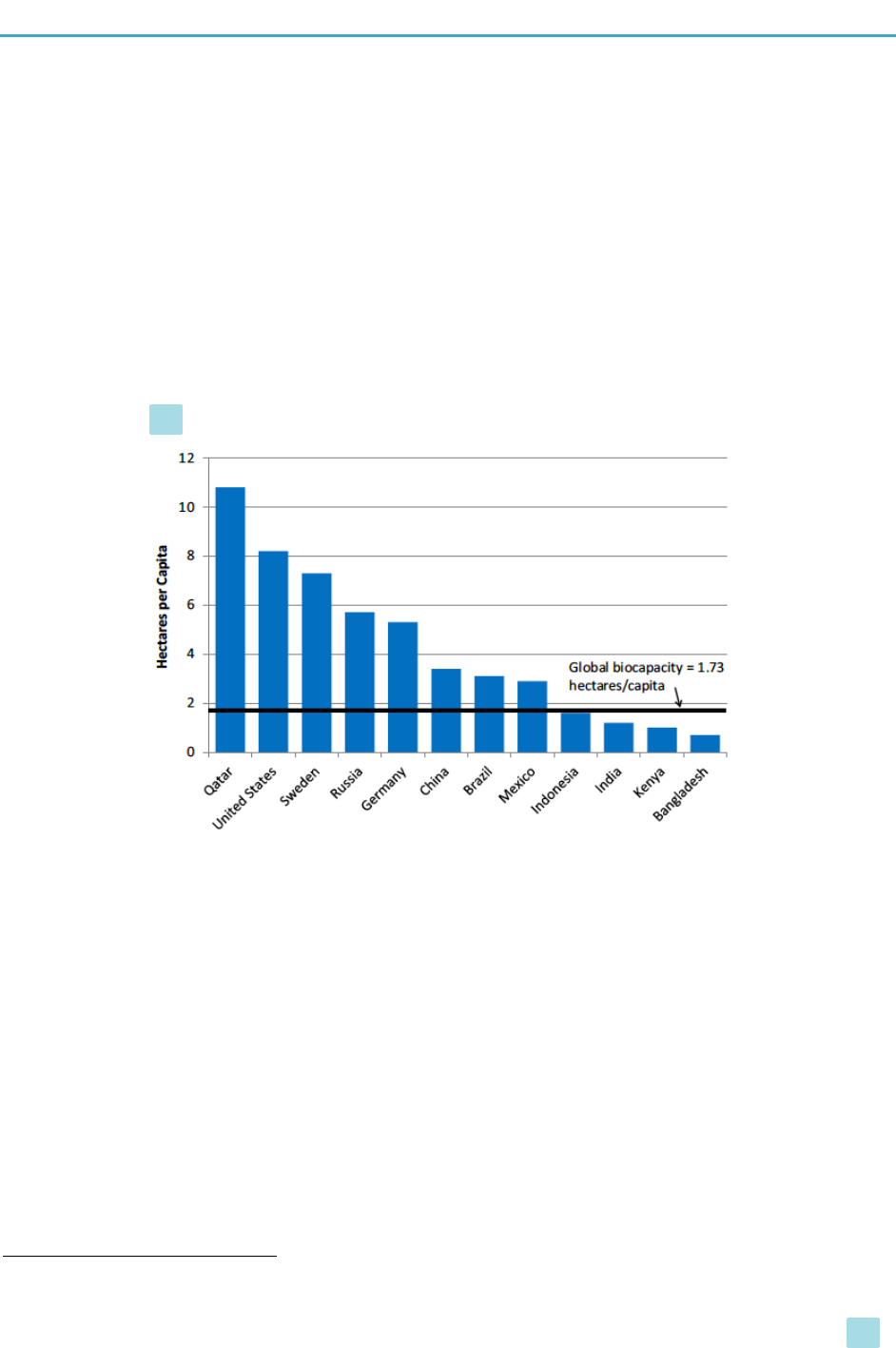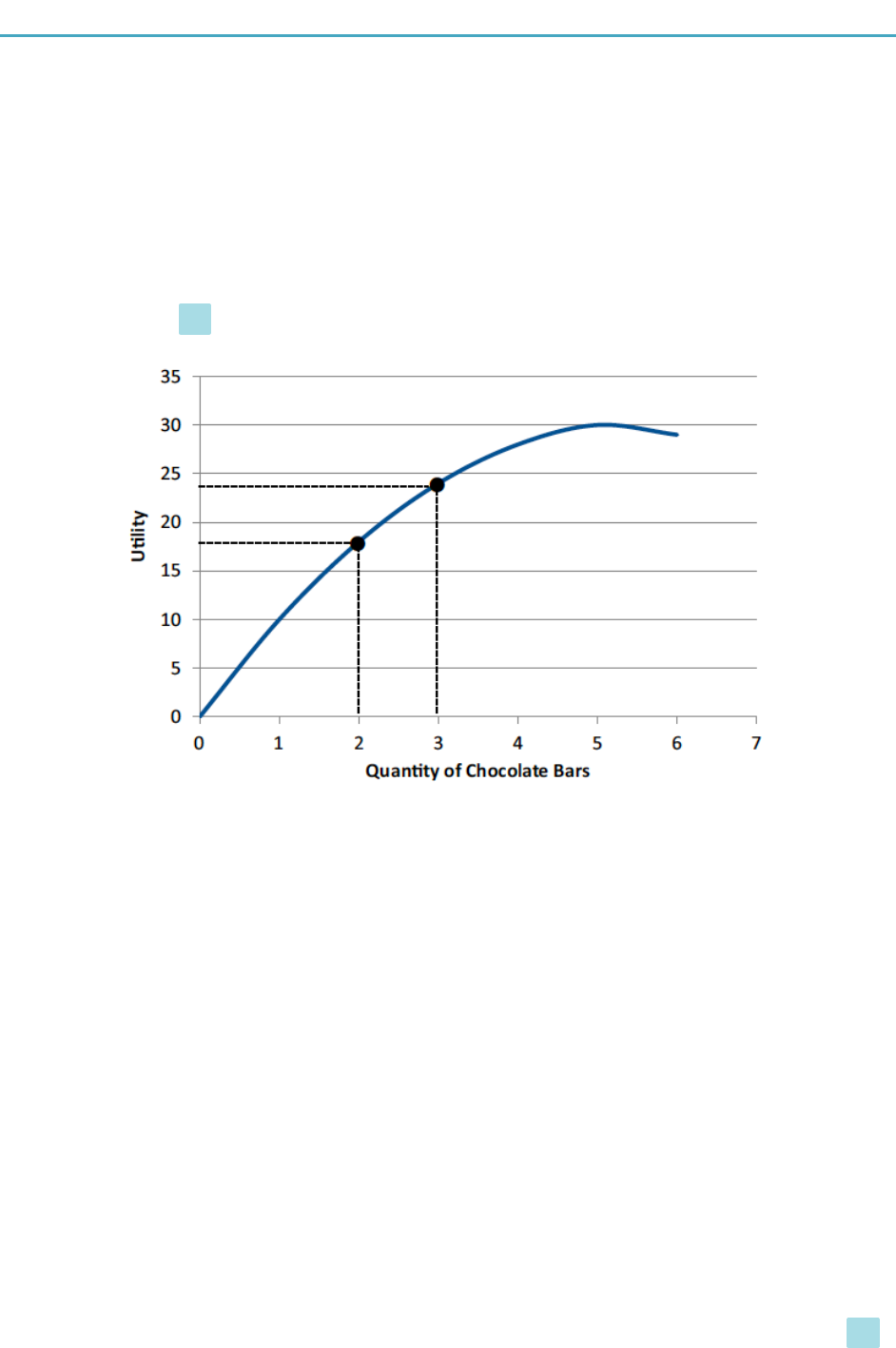
Global Development And Environment Institute
Tufts University
Medford, MA 02155
http://ase.tufts.edu/gdae
A GDAE Teaching Module on Social and Environmental Issues in Economics
By Brian Roach, Neva Goodwin, and Julie Nelson
Consumption and the
Consumer Society

This reading is based on portions of Chapter 8 from: Microeconomics in Context, Fourth Edition.
Copyright Routledge, 2019.
Copyright © 2019 Global Development And Environment Institute, Tufts University.
Reproduced by permission. Copyright release is hereby granted for instructors to copy this
module for instructional purposes.
Students may also download the reading directly from https://ase.tufts.edu/gdae
Comments and feedback from course use are welcomed:
Comments and feedback from course use are welcomed:
Global Development And Environment Institute
Tufts University
Somerville, MA 02144
http://ase.tufts.edu/gdae
E-mail: [email protected]
NOTE – terms denoted in bold face are defined in the KEY TERMS AND CONCEPTS section at the
end of the module.

CONSUMPTION AND THE CONSUMER SOCIETY
3
TABLE OF CONTENTS
1. INTRODUCTION ................................................................................................. 5
2. ECONOMIC THEORY AND CONSUMPTION ............................................... 5
2.1 Consumer Sovereignty .............................................................................................. 5
2.2 The Budget Line ....................................................................................................... 6
2.3 Consumer Utility ....................................................................................................... 9
2.4 Limitations of the Standard Consumer Model ........................................................ 11
3. CONSUMPTION IN HISTORICAL & INTERNATIONAL CONTEXT .... 13
3.1 A Brief History of Consumer Society ..................................................................... 13
3.2 Limits to Modern Consumerism ............................................................................. 16
Insufficient Consumption: Poverty .......................................................................... 16
Nonconsumerist Values ........................................................................................... 17
4. CONSUMPTION IN A SOCIAL CONTEXT .................................................. 18
4.1 Social Comparisons ................................................................................................ 18
4.2 Advertising .............................................................................................................. 20
4.3 Private Versus Public Consumption ....................................................................... 22
5. CONSUMPTION IN AN ENVIRONMENTAL CONTEXT .......................... 23
5.1 The Link Between Consumption and the Environment .......................................... 24
5.2 Green Consumerism ................................................................................................ 26
6. CONSUMPTION AND WELL-BEING ............................................................ 26
6.1 Does Money Buy Happiness? ................................................................................. 27
6.2 Affluenza and Voluntary Simplicity ....................................................................... 30
6.3 Consumption and Public Policy .............................................................................. 32
Flexible Work Hours ............................................................................................... 33

CONSUMPTION AND THE CONSUMER SOCIETY
4
Advertising Regulations ........................................................................................... 33
Consumption Taxation ............................................................................................. 34
KEY TERMS AND CONCEPTS ............................................................................... 36
REFERENCES .......................................................................................................... 38
DISCUSSION QUESTIONS ...................................................................................... 41

CONSUMPTION AND THE CONSUMER SOCIETY
5
1. INTRODUCTION
The economic activity of consumption is defined as the process by which goods and services are
put to final use by people. But this rather dry, academic definition fails to capture the multifaceted
role of consumerism in our lives. As one researcher put it:
For a start, it is immediately clear that consumption goes way beyond just satisfying
physical or physiological needs for food, shelter, and so on. Material goods are
deeply implicated in individuals’ psychological and social lives. People create and
maintain identities using material things… The “evocative power” of material
things facilitates a range of complex, deeply ingrained “social conversations” about
status, identity, social cohesion, and the pursuit of personal and cultural meaning.
1
Until recently, most economists paid little attention to the motivations behind consumer behavior.
Economic theory in the twentieth century simply assumed that the vast majority of people act
rationally to maximize their utility. But as suggested in the quotation above, perhaps no other
economic activity is shaped by its social context more than consumption. Our consumption
behavior conveys a message to ourselves and others about who we are and how we fit in with, or
separate ourselves from, other people.
Modern consumption must also be placed in a historical context. When can we say that “consumer
society” originated? Furthermore, is consumerism as experienced in the United States and other
countries something that is ingrained in us by evolution, or is it something that has been created
by marketing and other social and political forces?
Finally, it is impossible to present a comprehensive analysis of consumption without considering
its environmental context. Specifically, ecological research suggests that consumption levels in the
United States and many other developed countries have reached unsustainable levels. According
to one recent analysis, if everyone in the world had the same living standard as the average
American, we would need at least four earths to supply enough resources and process all the
waste.
2
So any serious discussion of sustainability must consider the future of consumption
patterns throughout the world.
2. Economic Theory and Consumption
2.1 Consumer Sovereignty
Before focusing on the historical, social, and environmental contexts of consumption, we present
the neoclassical economic theory on the topic. The neoclassical model is based on overly simplistic
assumptions about human behavior, but it still provides a useful basis for thinking about
consumption decisions.
1
Jackson, 2008, p. 49.
2
McDonald, 2015.

CONSUMPTION AND THE CONSUMER SOCIETY
6
Adam Smith once said, “Consumption is the sole end and purpose of all production and the welfare
of the producer ought to be attended to, only so far as it may be necessary for promoting that of
the consumer.”
3
The belief that satisfaction of consumers’ needs and wants is the ultimate
economic goal and that the economy is fundamentally ruled by consumer desires is called
consumer sovereignty. Consumer sovereignty suggests that all economic production is ultimately
driven by the preferences of consumers. For example, consider the fact that sales of sport utility
vehicles (SUVs) in the United States have been increasing in recent years, while sales of small
cars and sedans have declined.
4
The theory of consumer sovereignty would suggest that the
primary reason for the growth of SUV sales is that consumers prefer larger vehicles over cars. We
would argue that a change in consumers’ tastes and preferences increased the demand for SUVs
and decreased the demand for cars. The possibility that the shift in demand was driven primarily
by automakers’ marketing efforts to sell large vehicles with higher profit margins would not be
consistent with consumer sovereignty.
The notion of consumer sovereignty has both positive and normative components. From a positive
perspective, we can consider whether consumers really do “drive the economy.” Since consumers
can be swayed by advertising, we will consider the impact of advertising in more detail later in
this module.
Consumer sovereignty can also be viewed from a normative perspective. Should people’s
preferences, as consumers, drive all decisions about economic production, distribution, and
resource management? People are more than just consumers. Consumption activities most directly
address living standard (or lifestyle) goals, which have to do with satisfying basic needs and
getting pleasure through the use of goods and services.
But people are often interested in other goals, such as self-realization, fairness, freedom,
participation, social relations, and ecological balance. To some extent, these goals may be attained
through consumption, but often they conflict with their goals as consumers. Many people also
obtain intrinsic satisfaction from working and producing. Work can create and maintain
relationships. It can be a basis for self-respect and a significant part of what gives life purpose and
meaning.
If the economy is to promote well-being, all these goals must be taken into account. An economy
that made people moderately happy as consumers but absolutely miserable as workers, citizens, or
community members could hardly be considered a rousing success. We evaluate the relationship
between consumption and well-being further toward the end of this module. But first we turn to
the formal neoclassical theory on consumption.
2.2 The Budget Line
The choices that we make as consumers illustrate yet another example of economic tradeoffs. In
this case, consumers are constrained in their spending by the amount of their total budget. We can
represent this in a simple model in which consumers have only two goods from which to choose.
3
Smith, 1930, p. 625.
4
Bomey, 2017.

CONSUMPTION AND THE CONSUMER SOCIETY
7
In Figure 1, we present a budget line, which shows the combinations of two goods that a consumer
can purchase. In this example, our consumer—let’s call him Quong—has a budget of $8. The two
goods that are available for him to purchase are chocolate bars and bags of nuts. The price of
chocolate bars is $1 each, and nuts sell for $2 per bag.
Figure 1. The Budget Line
If Quong spends his $8 only on chocolate, he can buy 8 bars, as indicated by the point where the
budget line touches the vertical axis. If he buys only nuts, he can buy 4 bags, as indicated by the
(4, 0) point on the horizontal axis. He can also buy any combination in between. For example, the
point (2, 4), which indicates 2 bags of nuts and 4 chocolate bars, is also achievable. This is because
(2 Å~ $2) + (4 Å~ $1) = $8. (We draw the budget line as continuous to reflect the more general
case that might apply when there are many more alternatives, although here we assume that Quong
buys only whole bars and whole bags, not fractions of them.)
A budget line is similar to the concept of a production-possibilities frontier. A budget line defines
the choices that are possible for Quong. Points above and to the right of the budget line are not
affordable. Points below and to the left of the budget line are affordable but do not use up the total
budget. In this simple model, economists assume that people always want more of at least one of
the goods in question. Consuming below the budget line would therefore be inefficient; funds that
could be used to satisfy Quong’s desires are being left unused. Therefore, economists assume that
consumers will choose to consume at a point on the budget line.
The position of the budget line depends on the size of the total budget (income) and on the prices
of the two goods. For example, if Quong has $10 to spend, instead of $8, the line would shift
outward in a parallel manner, as shown in Figure 2. He could now consume more nuts, or more
chocolate, or a more generous combination of both.

CONSUMPTION AND THE CONSUMER SOCIETY
8
Figure 2. Effect of an Increase in Income
A change in the price of one of the goods will cause the budget line to rotate around a point on one
of the axes. So if the price of nuts dropped to $1 per bag (and Quong’s income was again $8), the
budget line would rotate out, as shown in Figure 3. Now, if Quong bought only nuts, he could buy
8 bags instead of 4. With the price of chocolate unchanged, however, he still could not buy more
than 8 chocolate bars.
Figure 3. Effect of a Fall in the Price of One Good

CONSUMPTION AND THE CONSUMER SOCIETY
9
Note that if both prices change, the budget line could shift in any direction, depending on how the
two prices changed. If both prices changed by the same percentage, then the new budget line would
be parallel to the original, similar to a change in income. Draw some graphs to prove this to
yourself.
A budget line tells us what combinations of purchases are possible, but it does not tell us which
combination a consumer will choose. To get to this, we must add the theory of utility.
2.3 Consumer Utility
Economists have traditionally defined consumers’ “problem” as how to maximize utility given
their income constraints. Utility is a somewhat vague concept. However, although economists
attempt to measure welfare quantitatively, utility is generally recognized as something that cannot
be measured quantitatively and cannot be aggregated across individuals.
5
We define utility as the
pleasure or satisfaction that individuals receive from consuming goods, services, or experiences.
Furthermore, we assume that individuals make consumer decisions to increase their utility. But,
we recognize that consumers often do not always make the best decisions, because they sometimes
act irrationally or are unduly influenced by certain information (or misinformation). We discuss
the implications of this further in the next section.
Economists have developed a neoclassical model of utility that, like many economic models, is an
abstraction from reality that is useful for illustrating a particular concept. So despite the fact that
we just said that utility cannot be measured quantitatively in the real world, for the purposes of our
model we assume that we actually can measure utility in some imaginary units of “satisfaction.”
Thus Table 1 presents the total utility that Quong obtains from purchasing different quantities of
chocolate bars in a given period, say a day.
Table 1. Quong’s Utility from Consuming Chocolate Bars
5
Some economists in the 1800s, such as William Stanley Jevons (1835–1882) actually did believe that utility was
something that could eventually be measured numerically.

CONSUMPTION AND THE CONSUMER SOCIETY
10
We can then plot Quong’s total utility from consuming chocolate bars in Figure 4. This relationship
between utility and the quantity of something consumed is called a utility function, or a total
utility curve.
Figure 4. Quong’s Utility Function for Chocolate Bars
Rather than looking at total utility, economists tend to focus on how utility changes from one level
of consumption to another. The change in utility for a one-unit change in consumption is known
as marginal utility. We can determine marginal utility by referring to Table 1. We see that Quong
obtains 10 units of “satisfaction” from consuming his first chocolate bar. While his utility increases
from 10 to 18 units by consuming his second chocolate bar, his marginal utility of the second
chocolate bar is only 8 units. Consuming his third chocolate bar, he obtains a marginal utility of 6
units.
We see in Figure 4 that Quong’s utility curve levels off as his consumption of chocolate bars
increases. This is generally expected—that successive units of something consumed provide less
utility than the previous unit. In other words, consumers’ utility functions generally display
diminishing marginal utility.
Now we can apply the concept of utility to the budget line that Quong faces. Realize that Quong
will also have a utility function for bags of nuts, which will display a similar pattern of diminishing
marginal utility. Let’s assume that his first bag of nuts provides him with 20 units of utility, his
second bag with 15 additional units, and his third bag with 10 additional units (more bags result in
even less units of utility). How can Quong allocate his limited budget to provide him with the
highest amount of total utility?
Using marginal thinking we can easily see how Quong can approach his problem in a purely
rational manner. Suppose that Quong is thinking about how he will spend his first $2. With $2 he
can buy either two chocolate bars or one bag of nuts. If he buys two chocolate bars, he will obtain

CONSUMPTION AND THE CONSUMER SOCIETY
11
18 total units of utility, as shown in Table 1. If he buys one bag of nuts instead, he will obtain 20
units of utility. Thus, Quong will receive greater utility by spending his first $2 on a bag of nuts.
What about his next $2? If he spends this on his second bag of nuts, he obtains an additional 15
units of utility. But if he instead purchases his first two chocolate bars, he will obtain 18 units of
utility. So, by spending his next $2 on chocolate bars, he increases his utility by a greater amount.
After spending $4 Quong has purchased one bag of nuts and two chocolate bars, thus obtaining a
total utility of 38 units. Quong can continue to apply marginal thinking to maximize his utility
until he has eventually spent his entire budget. (Test yourself: How will Quong spend his third $2,
by buying another bag of nuts or two more bars of chocolate?)
6
The basic decision rule to maximize
utility is to allocate each additional dollar on the good or service that provides the greatest marginal
utility for that dollar.
7
2.4 Limitations of the Standard Consumer Model
We suspect that you have never thought about how to spend your money in a manner similar to
Quong’s marginal analysis of chocolate and nuts. It is less important that people behave exactly
as a model suggests than it is to consider whether people generally act as if they are always trying
to increase their utility as much as possible. There are several reasons to be skeptical about this.
First, the utility model assumes that people are rational. But this is not always the case. The model
also assumes that all the benefits from consumption can be identified, compared, and added up.
While comparing the utility from chocolate and nuts may be relatively easy to imagine, consumers’
decisions become much more complicated when they are faced with a wide variety of options.
Economists have traditionally assumed that having more options from which to choose can only
benefit consumers, but recent research demonstrates that there is a cost to trying to process
additional information. In fact, having too many choices can actually “overload” our ability to
evaluate different options. Consider a famous example demonstrating the effect of having too
much choice.
8
In one experiment, researchers at a supermarket in California set up a display table
with six different flavors of jam. Shoppers could taste any (or all) of the six flavors and receive a
discount coupon to purchase any flavor. About 30 percent of those who tried one or more jams
ended up buying some.
The researchers then repeated this experiment but, instead, offered 24 flavors of jam for tasting. In
this case, only 3 percent of those who tasted a jam went on to buy some. In theory, it would seem
that more choice would increase the chances of finding a jam that one really liked and would be
willing to buy. But, instead, the additional choices decreased one’s motivation to make a decision
to buy a jam. A 2010 article from The Economist addressed this topic:
6
If he buys his second bag of nuts, he will obtain 15 units of utility. If he buys two more chocolate bars, he will obtain
10 units of utility (6 units for his third bar, and 4 for his fourth bar). Thus he is better off buying another bag of nuts.
7
As most goods and services are not available in $1 increments, such as bags of nuts, consumers in this model will
not always be able to allocate every single dollar in a way that maximizes utility.
8
Iyengar and Lepper, 2000.

CONSUMPTION AND THE CONSUMER SOCIETY
12
As options multiply, there may be a point at which the effort required to obtain
enough information to be able to distinguish sensibly between alternatives
outweighs the benefit to the consumer of the extra choice. “At this point,” writes
Barry Schwartz in The Paradox of Choice, “choice no longer liberates, but
debilitates. It might even be said to tyrannise.” In other words, as Mr. Schwartz puts
it, “the fact that some choice is good doesn’t necessarily mean that more choice is
better.”
Daniel McFadden, an economist at the University of California, Berkeley, says that
consumers find too many options troubling because of the “risk of misperception
and miscalculation, of misunderstanding the available alternatives, of misreading
one’s own tastes, of yielding to a moment’s whim and regretting it afterwards,”
combined with “the stress of information acquisition.”
9
Another important point is that when consumers make a decision to purchase a good or service,
they are essentially making a prediction about the utility that the purchase will bring them. Daniel
Kahneman distinguishes between predicted utility and remembered utility. Predicted utility is the
utility that you expect to obtain from a purchase (or other experience), whereas remembered utility
is the utility that you actually recall after you have made a purchase. In other words, Kahneman
considers whether people actually receive the benefits they expect in advance of their purchases.
According to the standard consumer model with rational decision makers, these two utilities should
match relatively closely.
Once again research from behavioral economics suggests that people’s predictions can often turn
out to be incorrect. In one well-known experiment, young professors were asked to predict the
effect of their tenure decision on their long-term happiness. Although being granted tenure
essentially ensures a professor lifetime employment, being denied tenure means he or she must
find a new job. Most young professors predict that being denied tenure will have a long-term
negative impact on their happiness. Yet surveys of professors who actually have and have not been
granted tenure indicate that there is no significant long-term effect of tenure decision on happiness
levels. A similar experiment showed that college students over-predicted the negative effects of a
romantic breakup.
10
These findings have implications for welfare analysis. Realize that a demand curve is an expression
of predicted utility. Welfare analysis measures consumer surplus based on demand curves, thus
implicitly assuming that predicted utility matches well with remembered utility. But if predicted
and remembered utility differs, any welfare implications based on demand curves will be
inaccurate— not reflective of the utility that people actually receive from their purchases.
We must also recognize the potential for consumers to be swayed by advertising and other
influences into making poor consumer decisions. Advertising expenditures in the United States
totaled about $200 billion in 2016, equivalent to more than $600 per person.
11
Of course, the
9
Anonymous, 2010.
10
Gilbert et al., 1998.
11
Advertising Age, 2015.

CONSUMPTION AND THE CONSUMER SOCIETY
13
purpose of advertising is not necessarily to assist consumers to make the best choices. We further
discuss the impact of advertising later in this module.
3. CONSUMPTION IN HISTORICAL AND INTERNATIONAL CONTEXT
Perhaps the greatest limitation of the neoclassical consumer model is that it does not really tell us
anything interesting about why consumers make particular choices. For example, why might
Quong purchase so many chocolate bars that it has a negative impact on his health? Can someone
who smokes cigarettes truly be acting in a utility-maximizing manner? Why do people acquire
huge credit card debts by making seemingly frivolous purchases? Why would someone spend
$60,000 or more on a new car when a car costing much less may be perfectly adequate for all
practical purposes?
To answer such questions, we must recognize the historical and social nature of consumption. We
are so immersed in a culture of consumption that we can be said to be living in a consumer society,
a society in which a large part of people’s sense of identity and meaning is achieved through the
purchase and use of consumer goods and services. Viewing consumption through the lens of a
consumer society is quite different from looking at consumption from the neoclassical model of
consumer behavior.
We first consider the historical evolution of consumer society, along with the institutions that
allowed consumer society to flourish. Then we take a brief look at consumer society around the
world today.
3.1 A Brief History of Consumer Society
When can we say that consumer society originated? Historians have placed the birth of the
consumer society variously from the sixteenth century to the mid-1900s.
12
To some extent, the
answer depends on whether we consider consumerism, understood as having one’s sense of
identity and meaning defined largely through the purchase and use of consumer goods and
services, as an innate human characteristic. In other words, does consumerism come naturally to
humans or is it an acquired trait? Of course, for thousands of years in many societies a small elite
class has existed that enjoyed higher consumption standards and bought luxury goods and services.
One story of the birth of consumer society says that it is human nature to want to acquire more
goods, so all that is needed for the birth of consumer society is for a significant portion of the
population to have more money than is necessary for basic survival. However, this explanation is
incorrect or at least a vast oversimplification.
Before the eighteenth century, families and communities that acquired more than enough to meet
basic needs did not automatically respond by becoming consumers. Religious value systems
generally taught material restraint. Patterns of dress and household display were dictated by
tradition, depending on the class to which one belonged, with little change over time. Unlike the
12
Material from this section is drawn primarily from Stearns, 2006.

CONSUMPTION AND THE CONSUMER SOCIETY
14
norm in modern times, in the past emphasis was more often placed on community spending, such
as for a new church, as opposed to private spending.
The historical consensus is that consumer society as a mass phenomenon originated in the
eighteenth century in Western Europe. Although it is no coincidence that this time and location
coincides with the birth of the Industrial Revolution, consumer society was not solely the result of
greater prosperity. The Industrial Revolution clearly transformed production. It is less obvious, but
equally true, that it transformed consumption, as much through the social changes it produced as
through the economic changes.
The arrival of consumerism in Western Europe involved truly revolutionary change
in the way goods were sold, in the array of goods available and cherished, and in
the goals people defined for their daily lives. This last—the redefinition of needs
and aspirations—is the core feature of consumerism.
13
The large-scale emigration of people from the agricultural countryside to cities in search of work
brought significant social disruption. Instead of finding personal and social meaning in tradition
and community, as they had in the past, people sought new ways to define themselves, often
through consumer goods. Shopkeepers for the first time began to create window displays, engage
in newspaper advertising, and use other methods to attract customers. Furthermore, the breakdown
of strict class lines meant that common people had the freedom to express themselves in new ways,
including displays of wealth that would have been discouraged, or even illegal, in the past.
Although consumerism took root in the eighteenth century, it took some time before it fully
blossomed. At the dawn of industrialization, it was not at all clear that workers would become
consumers. Early British industrialists complained that their employees would work only until they
had earned their traditional weekly income and then stop until the next week. Leisure, it appeared,
was more valuable to the workers than increased income. This attitude, widespread in pre-
industrial societies, was incompatible with mass production and mass consumption. It could be
changed in either of two ways.
At first, employers responded by lowering wages and imposing strict discipline on workers to force
them to work longer hours. Early textile mills frequently employed women, teenagers, and even
children, because they were easier to control and could be paid less than adult male workers. As a
consequence of such draconian strategies of labor discipline, living and working conditions for the
first few generations of factory workers were generally worse than in the generations before
industrialization.
Over time, however, organized workers, political reformers, and humanitarian groups pressured
for better wages, hours, and working conditions, while rising productivity made businesses more
open to meeting some of these demands. A second response to the pre-industrial work ethic
gradually evolved: As workers came to see themselves as consumers, they would no longer choose
to stop work early and enjoy more leisure. Instead, they preferred to work full-time, or even
overtime, in order to earn and spend more. In the United States, the “worker as consumer” view
13
Stearns, 2006, p. 25.

CONSUMPTION AND THE CONSUMER SOCIETY
15
was fully entrenched by the 1920s, when the labor movement stopped advocating a shorter
workweek and instead focused on better wages and working conditions.
Other historical developments were important to the spread of consumer society. One was the
invention of the department store, in the mid-nineteenth century in England. Department stores
quickly spread to other European countries and the United States. Featuring lavish displays,
department stores presented shoppers with the opportunity to purchase an entirely new lifestyle,
all under one roof. Department stores introduced the idea of shopping as “spectacle,” with
entertainment, elaborate interiors, seasonal displays, and parades.
14
The department store was a permanent fair, a dream world, a spectacle of excessive
proportions. Going to the store became an event and an adventure. One came less
to purchase a particular article than to simply visit, to browse, to see what was new,
to try on new fashions and even new identities.
15
Modern shopping malls originated in the United States in the early twentieth century.
Suburbanization in the United States in the mid-twentieth century was supported by the
construction of large shopping malls far from city centers but easily accessible by automobile. By
the 1980s and 1990s enormous shopping malls, such as the Mall of America in Minnesota, were
being constructed with entertainment options including indoor roller coasters and aquariums.
Another institution created to support consumerism was expanded consumer credit, particularly
the invention of credit cards in the 1940s. Although some cardholders use them only for
convenience, paying off their balances in full each month, about half of cardholders use them as a
form of borrowing by carrying unpaid balances, on which they pay interest, with annualized rates
that can exceed 30 percent.
16
Figure 5 illustrates the growth of revolving debt in the United States over the past several decades,
adjusted for inflation.
17
We see that revolving debt, which consists almost entirely of credit card
debt, increased by a factor of 100 from 1968 until about 2007, when the Great Recession caused
households to reduce their debt, as spending declined and credit became less available. More
recently credit card debt has begun to rise again, although it hasn’t yet reached the peak level prior
to the financial crisis. In mid-2017, total outstanding revolving debt in the United States was about
$960 billion, equivalent to more than $7,600 per household. However, given that about half of
households do not carry an unpaid monthly balance on their credit cards, those households that do
carry a balance had an average credit card debt of around $15,000.
14
Ritzer, 1999.
15
Goodman and Cohen, 2004, p. 17.
16
Wolff-Mann, 2016.
17
Revolving debt allows consumers to borrow money against a line of credit, without the requirement that the amount
borrowed be fully paid off each month. Thus the balance from one or more months can carry over, or “revolve,” to
the next month. The vast majority of revolving debt is credit card debt.

CONSUMPTION AND THE CONSUMER SOCIETY
16
Figure 5. Revolving Debt in the United States, 1968-2017, Adjusted for Inflation
Sources: Federal Reserve, Consumer Credit (G.19); CPI data from the Bureau of Labor Statistics.
3.2 Limits to Modern Consumerism
Can we say, at the start of the twenty-first century, that consumerism has become a global
phenomenon? It is true that people all over the world are increasingly exposed to similar
commercial messages and images of “the good life,” but consumer society is not yet universal for
two main reasons. First, the majority of people around the world are simply too poor to be
considered modern consumers. Over 700 million people, about 10 percent of humanity, live in
“extreme” poverty, defined by the World Bank as living on less than $1.90 per day.
18
Even further,
71 percent of the world’s population lives on less than $10 per day, according to a 2015 report.
19
While an income of $10 per day is considered the minimum necessary for a degree of economic
security, it is not enough to support a consumerist lifestyle. The second reason consumerism is not
yet universal is that in numerous places around the world cultural and religious values exist that
seek to restrain, or even reject, the consumer society. We first discuss global poverty and then turn
to a brief discussion of nonconsumer values.
Insufficient Consumption: Poverty
Poverty is about more than just a low income. The United Nations defines absolute deprivation
as “a condition characterized by severe deprivation of basic human needs, including food, safe
drinking water, sanitation facilities, health, shelter, education and information. It depends not only
on income but also on access to services.”
20
The poorest of developing countries, particularly in
18
http://povertydata.worldbank.org/poverty/home/.
19
Kochhar, 2015.
20
http://www.un.org/esa/socdev/wssd/text-version/agreements/poach2.htm.

CONSUMPTION AND THE CONSUMER SOCIETY
17
sub-Saharan Africa and Southern Asia, often lack the resources needed to lift their populations out
of absolute deprivation. Increasingly, however, the more economically successful developing
countries in Asia and Latin America have sufficient resources to provide everyone with basic
necessities. The fact that absolute deprivation still exists for the poor in these countries reflects
inequality in the distribution of income. Absolute deprivation may also vary with factors such as
race and ethnicity and even within a household on the basis of age or gender.
Because insufficient consumption is not simply a matter of having a low household income,
however, even in regions that could be generally characterized as middle or high income, examples
of absolute deprivation can still be found. Some people—particularly young children and the ill
and handicapped—have dependency needs for care that may be unmet. Even people with a fairly
high household income by global standards may sometimes find themselves lacking basic
necessities. Advocates for the elderly, the sick, and children, for example, often claim that the
United States has an inadequate system of care.
Absolute deprivation is only one type of insufficiency. Modern technology means that nearly
everyone has some exposure to the “lifestyles of the rich and famous.” The result is the creation
of widespread feelings of relative deprivation, that is, the sense that one’s own condition is
inadequate because it is inferior to someone else’s circumstances. Relative deprivation is a
condition that exists in all countries to some extent. The government-defined poverty level in the
United States was $24,600 for a family of four in 2017.
21
This income would be at or above the
national average in many countries; in most developing countries, a family income of $24,600
would be considered wealthy. It may be possible to buy the bare physical necessities of life for
this sum, even in the United States—at least in areas of the country with low housing costs. Yet it
is likely that most of the Americans who fall below the poverty level (13 percent of the population
in 2016
22
) do not feel able to enjoy a “normal” American lifestyle. They clearly do not have the
resources to buy the kinds of homes, cars, clothing, and other consumer goods commonly shown
on American television. The 18 percent of U.S. children who live in poverty
23
do not start out on
an “even playing field” with nonpoor children, in terms of nutrition, health care, and other
requirements. The fact that people who cannot afford to consume at “normal” societal consumption
levels feel relative deprivation suggests that poverty, even relative poverty, is not conducive to
promoting well-being and self-respect.
Nonconsumerist Values
The spread of consumerism has met considerable resistance in some societies, usually because it
conflicts with existing values, either religious or secular. For example, the Muslim concept of riba
prohibits charging interest on loans. Buddhism teaches a “middle path” that emphasizes material
simplicity, nonviolence, and inner peace. Various passages of the New Testament of the Bible
emphasize the spiritual dangers of wealth, such as the saying that it is easier for a camel to pass
through the eye of a needle than for a rich man to enter heaven.
Traditional cultural values in some countries have restrained the spread of consumerism. In some
countries, consumerism is associated with foreign, typically American, values.
21
https://aspe.hhs.gov/poverty-guidelines.
22
Semega et al., 2017.
23
Ibid.

CONSUMPTION AND THE CONSUMER SOCIETY
18
Consumption expansion thus tends to lead to some level of global homogenization
of culture among consumers, an effect that gives rise to negative responses to
globalization. As consumer goods are always also cultural goods, expansion of
consumption of imported products and services often gives rise to an exaggerated
sense of “panic,” of cultural “invasion” which, supposedly, if left unchecked will
result in the demise of the local culture.
24
Social norms and government policies in various European countries aim to promote
nonconsumerist values. For example, many retail stores in France, Italy, and other European
countries are normally closed at lunchtime and on Sundays. European policies on vacation time,
parental leave, and flexible working hours emphasize a work–life balance.
Even in the United States, the spread of consumerism has not been an even, uninterrupted process.
The history of consumer society in the United States reveals periodic movements against
consumerism. The Quakers in the eighteenth century, the Transcendentalists of the mid-nineteenth
century (most famously, Henry David Thoreau), the Progressives at the turn of the twentieth
century, and the hippies of the 1960s all espoused a simpler, less materialistic life philosophy.
25
More recently, starting in the 1980s the idea of voluntary simplicity, which we discuss further later
in the module, has attracted a following among Americans motivated by objectives such as
reducing environmental impacts, focusing more on family and social connections, healthy living,
and stress reduction.
4. CONSUMPTION IN A SOCIAL CONTEXT
As mentioned at the beginning of this module, in modern consumer societies consumption is as
much a social activity as an economic activity. Consumption is tied closely to personal identity,
and it has become a means of communicating social messages. An increasing range of social
interactions are influenced by consumer values.
Consumption pervades our everyday lives and structures our everyday practices.
The values, meanings, and costs of what we consume have become an increasingly
important part of our social and personal experiences… [Consumption] has entered
into the . . . fabric of modern life. All forms of social life—from education to sexual
relations to political campaigns—are now seen as consumer relations.
26
4.1 Social Comparisons
As social beings, we compare ourselves to other people. Our income and consumption levels are
some of the most important ways in which we evaluate ourselves relative to others. As discussed
above, whether people consider themselves poor often depends on the condition of those around
them.
24
Goodman and Cohen, 2004, p. 68.
25
See Shi, 2007.
26
Goodman and Cohen, 2004, pp. 1–4.

CONSUMPTION AND THE CONSUMER SOCIETY
19
You have probably heard of the saying “Keeping up with the Joneses.” This saying refers to the
motivation to maintain a material lifestyle that is comparable to those around us. A reference
group is a group of people who influence the behavior of consumers because they compare
themselves with that group. Most people have various reference groups, traditionally including our
neighbors, our coworkers, and other members of our family. We also are influenced as consumers
by aspirational groups, groups to which a consumer wishes he or she could belong. People often
buy, dress, and behave like the group—corporate executives, rock stars, athletes, or whoever—
with whom they would like to identify.
Economist Juliet Schor argues that the nature of social comparisons related to consumption has
changed in the past few decades. She suggests that in the 1950s and 1960s the idea of “Keeping
up with the Jones” emphasized comparisons between individuals or families with similar incomes
and backgrounds. Because prosperity was broadly shared in the postwar decades, people did not
want to feel left out as new consumer goods and living standards emerged. More recently, however,
she has observed a different approach to consumption comparisons.
Beginning in the 1980s, those conditions changed, and what I have termed the new
consumerism emerged. The new consumerism is more upscale in the sense that
there is more aggressive, rather than defensive, consumption positioning. The new
consumerism is more anonymous and is less socially benign than the old regime of
keeping up with the Joneses. In part, this is because reference groups have become
vertically elongated. People are now more likely to compare themselves with, or
aspire to the lifestyle of, those far above them in the economic hierarchy.
27
Schor presents the results of a survey to support this view, which indicates that 85 percent of
respondents aspire to become someone who “really made it” or is at least “doing very well.” But
the survey results also show that only 18 percent of Americans are members of these groups based
on income.
28
If 85 percent of people aspire to be in the top 18 percent, obviously most will end up
disappointed.
Changes in economic inequality are also relevant to her hypothesis. During the 1950s and 1960s,
economic inequality in the United States was decreasing—that is, the gap between different levels
of the income hierarchy was generally shrinking. However, beginning in the 1970s economic
inequality began to increase, thus making it difficult to even maintain the existing distance between
an individual and his or her aspirational group.
Media representations of wealthy lifestyles also became more common. In the 1950s and 1960s,
most television shows depicted middle-class lifestyles. But starting in the 1980s, television shows
as well as advertisements increasingly depicted upper-class lifestyles. Exposure to media
representations of wealth influences people’s values and spending patterns. Schor’s own research
indicates that the more television a person watches, the more he or she is likely to spend, holding
constant other variables such as income. Higher rates of television watching have also been
associated with having materialistic values.
29
Other research has found that heavy television
27
Schor, 1999, p. 43.
28
Schor, 1998.
29
Shrum et al., 2005.

CONSUMPTION AND THE CONSUMER SOCIETY
20
watchers are likely to overstate the percentage of the population that owns luxury items, such as
convertibles and hot tubs, or that have maids or servants.
30
Schor’s conclusion is that identifying with unrealistic aspirational groups leads many people to
consume well above their means, acquiring large debts and suffering frustration as they attempt to
join those groups through their consumption patterns but fail to achieve the income to sustain them.
As people tend to evaluate themselves relative to reference and aspirational groups, with increasing
inequality some may feel as if they are falling behind even if their incomes are actually increasing.
The more our consumer satisfaction is tied to social comparisons—whether
upscaling, just keeping up, or not falling too far behind—the less we achieve when
consumption grows, because the people we compare ourselves to are also
experiencing rising consumption. The problem is not just that more consumption
doesn’t yield more satisfaction, but that it always has a cost. The extra hours we
have to work to earn the money cut into personal and family time. Whatever we
consume has an ecological impact. We find ourselves skimping on invisibles such
as insurance, college funds, and retirement savings as the visible commodities
somehow become indispensable. We are impoverishing ourselves in pursuit of a
consumption goal that is inherently unattainable. In the words of one focus-group
participant, we “just don’t know when to stop and draw the line.”
31
4.2 Advertising
Although advertising has existed as a specialized profession for only about a century, it has become
a force that rivals education and religion in shaping public values and aspirations. We already saw
that advertising spending in the United States totals about $600 per person annually. According to
one estimate, Americans are exposed to around 5,000 commercial messages per day, up from
around 2,000 per day in the 1980s.
32
Global advertising expenditures were about $520 billion in 2016, equivalent to the national
economy of Argentina or Sweden. About one-third of global advertising spending takes place in
the United States (see Figure 6). China recently became the world’s second-largest advertising
market. Per-capita advertising spending in China increased from just 9 cents in 1986 to $61 in
2016.
Advertising is often justified by economists as a source of information about products and services
available in the marketplace. Although it certainly plays that role, it also does much more.
Advertising appeals to many different values, emotional as well as practical needs and a range of
desires and fantasies. The multitude of advertisements that we encounter carry their own separate
messages; yet on a deeper level, they all share a common, powerful cultural message.
30
O’Guinn and Shrum, 1997.
31
Schor, 1998, pp. 107–109.
32
Story, 2007.

CONSUMPTION AND THE CONSUMER SOCIETY
21
What the vast amount of advertising really sells is consumer culture itself. Even if
advertising fails to sell a particular product, the advertisements still sell the
meanings and values of a consumer culture. As Christopher Lasch writes, “The
importance of advertising is not that it invariably succeeds in its immediate purpose,
…but simply that it surrounds people with images of the good life in which
happiness depends on consumption. The ubiquity of such images leaves little space
for competing conceptions of the good life.”
33
Figure 6. Advertising Expenditures, by Country/Region, 2016
Source: Advertising Age, 2015.
According to one estimate, the typical American will spend about three years of his or her life
watching television ads.
34
We have already mentioned how watching television can influence
people’s spending behavior and values. Other research details how television, and advertising in
particular, is associated with obesity, attention deficit disorder, heart disease, and other negative
consequences. Furthermore, advertising commonly portrays unrealistic body images, traditionally
for women but more recently for men as well. (See Box 1 for more on the effects of advertising on
girls and women.)
33
Goodman and Cohen, 2004, pp. 39–40.
34
Holt et al., 2007.

CONSUMPTION AND THE CONSUMER SOCIETY
22
BOX 1: WOMEN AND ADVERTISING
A 2007 report by the American Psychological Association concluded that advertising and other
media images encourage girls to focus on physical appearance and sexuality, with harmful results
for their emotional and physical well-being.
35
The research project reviewed data from numerous
media sources, including television, music videos and lyrics, movies, magazines, and video games.
The report found that 85 percent of the sexualized images of children were of girls.
The lead author of the report, Dr. Eileen L. Zurbriggen, said, “The consequences of the
sexualization of girls in media today are very real and are likely to be a negative influence on girls’
healthy development. We have ample evidence to conclude that sexualization has negative effects
in a variety of domains, including cognitive functioning, physical and mental health, and healthy
sexual development.”
Three of the most common mental health problems associated with exposure to sexualized images
and unrealistic body ideals are eating disorders, low self-esteem, and depression. It is estimated
that 8 million Americans suffer from an eating disorder—7 million of them women. About 20
percent of anorexics will eventually die from the disorder.
36
According to a 2012 article, most
female models would be considered anorexic according to their body mass index. Twenty years
ago the average model weighed 8 percent less than the average woman; now it is 23 percent less.
37
Jean Kilbourne, an author and filmmaker who holds a Ph.D. in education, has been lobbying for
advertising reforms since the 1960s. She has produced four documentaries on the negative effects
of advertising on women, most recently in 2010, under the title Killing Us Softly. Kilbourne notes
that virtually all photos of models in advertisements have been touched up, eliminating wrinkles,
blemishes, extra weight, and even skin pores. She believes that we need to change the environment
of advertising through public policy.
38
Dr. Zurbriggen concludes, “As a society, we need to replace
all of these sexualized images with ones showing girls in positive settings—ones that show the
uniqueness and competence of girls.”
4.3 Private Versus Public Consumption
The growth of consumerism has altered the balance between private and public consumption.
Public infrastructure has been shaped by the drive to sell and consume new products and the
availability of public and private options, in turn, shapes individual consumer choices.
In the early 1930s, for example, many major U.S. cities—including Los Angeles— had extensive,
relatively efficient, and nonpolluting electric streetcar systems. Then, in 1936, a group of
35
Anonymous, 2007.
36
South Carolina Department of Mental Health, Eating Disorder Statistics, www.state.sc.us/dmh/anorexia
37
Lovett, 2012.
38
Jean Kilbourne Web site, www.jeankilbourne.com.

CONSUMPTION AND THE CONSUMER SOCIETY
23
companies involved in bus and diesel gasoline production, led by General Motors, formed a group
called the National City Lines (NCL). They bought up electric streetcar systems in 45 cities and
dismantled them, replacing them with bus systems that also tended to promote automobile
dependency.
39
U.S. government support for highway construction in the 1950s further hastened
the decline of rail transportation, made possible the spread of suburbs far removed from
workplaces, and encouraged the purchase of automobiles.
Many of the choices that you have, as an individual, depend on decisions made for you by
businesses and governments. Los Angeles would look much different today—more like the older
sections of many East Coast and European cities—if it had been built up around streetcar lines
rather than cars and buses. Even today one can see tradeoffs between public (or publicly accessible)
infrastructure and private consumption. As more people carry cell phones and bottled water, pay
telephones and drinking fountains either cease to exist or become less well maintained, leading
more people to carry cell phones and bottled water.
5. CONSUMPTION IN AN ENVIRONMENTAL CONTEXT
The production process that creates every consumer product requires natural resources and
generates some waste and pollution. However, we are normally only vaguely aware of the
ecological impact of the processes that supply us with consumer goods.
The problem is that we do not often see the true ugliness of the consumer economy
and so are not compelled to do much about it. The distance between shopping malls
and their associated mines, wells, corporate farms, factories, toxic dumps, and
landfills, sometimes half a world away, dampens our perceptions that something is
fundamentally wrong.
40
Most of us are unaware that, for example, it requires about 600 gallons of water to make a quarter-
pound hamburger or that making a computer chip generates 4,500 times its weight in waste.
41
(For
another example of the ecological impacts of consumption, see Box 2.)
BOX 2: THE ENVIRONMENTAL STORY OF A T-SHIRT
T-shirts, along with jeans, are perhaps the most ubiquitous articles of clothing on college
campuses. What is the environmental impact of each of these T-shirts?
42
Consider a T-shirt constructed of a cotton/polyester blend, weighing about four ounces. Polyester
39
https://en.wikipedia.org/wiki/National_City_Lines.
40
Orr, 1999, pp. 145–146.
41
Ryan and Durning, 1997.
42
Material drawn from Ryan and Durning, 1997.

CONSUMPTION AND THE CONSUMER SOCIETY
24
is made from petroleum—a few tablespoons are required to make a T-shirt. During the extraction
and refining of the petroleum, one-fourth of the polyester’s weight is released in air pollution,
including nitrogen oxides, particulates, carbon monoxide, and heavy metals. About 10 times the
polyester’s weight is released in carbon dioxide, contributing to global climate change.
Cotton grown with nonorganic methods relies heavily on chemical inputs. Cotton accounts for 10
percent of the world’s use of pesticides. A typical cotton crop requires six applications of
pesticides, commonly organophosphates that can damage the central nervous system. Cotton is
also one of the most intensely irrigated crops in the world. T-shirt fabric is bleached and dyed with
chemicals including chlorine, chromium, and formaldehyde. Cotton resists coloring, so about one-
third of the dye may be carried off in the waste stream. Most T-shirts are manufactured in Asia
and then shipped by boat to their destination, with further transportation by train and truck. Each
transportation step involves the release of additional air pollution and carbon dioxide.
Despite the impacts of T-shirt production and distribution, most of the environmental impact
associated with T-shirts occurs after purchase. Washing and drying a T-shirt just 10 times requires
about as much energy as was needed to manufacture the shirt. Laundering will also generate more
solid waste than the production of the shirt, mainly from sewage sludge and detergent packaging.
How can one reduce the environmental impacts of T-shirts? One obvious step is to avoid buying
too many shirts in the first place. Buy shirts made of organic cotton or recycled polyester or
consider buying used clothing. Wash clothes only when they need washing, not necessarily every
time you wear something. Make sure that you wash only full loads of laundry and wash using cold
water whenever possible. Finally, avoid using a clothes dryer—clothes dry naturally for free by
hanging on a clothesline or a drying rack.
5.1 The Link Between Consumption and the Environment
In quantifying the ecological impacts of consumerism, most people focus on the amount of “trash”
generated by households and businesses. In 2014, the U.S. economy generated over 250 million
tons of municipal solid waste, which consisted mostly of paper, food waste, and yard waste.
Although the total amount of municipal solid waste generated has increased in recent decades (an
increase of nearly 200 percent since 1960), the portion recycled has increased from around 6
percent in the 1960s to about 35 percent today.
43
But most of the waste generation in a consumer society occurs during the extraction, processing,
or manufacturing stages—these impacts are normally hidden from consumers. According to a 2012
analysis, the U.S. economy requires about 8 billion tons of material inputs annually, which is
equivalent to more than 25 tons per person.
44
The vast majority of this material is discarded as
mining waste, crop residue, logging waste, chemical runoff, and other waste prior to the
consumption stage.
43
U.S. EPA, 2016.
44
Gierlinger and Krausmann, 2012.

CONSUMPTION AND THE CONSUMER SOCIETY
25
Perhaps the most comprehensive attempt to quantify the overall ecological impact of consumption
is the ecological footprint measure. This approach estimates how much land area a human society
requires to provide all that it takes from nature and to absorb its waste and pollution. Although the
details of the ecological footprint calculations are subject to debate, it does provide a useful way
to compare the overall ecological impact of consumption in different countries.
We see in Figure 7 that the ecological footprint per capita varies significantly across countries.
The United States has one of the highest per-capita ecological footprints (the per-capita footprints
of only four countries are higher, including Qatar and Australia).
45
The average European has a
footprint about 40 percent lower than the U.S. level, while the typical Chinese has a footprint 60
percent lower. The average Indian has an ecological footprint seven times lower than the average
American.
Figure 7. Ecological Footprint per Capita, Select Countries, 2012
Source: Global Footprint Network, 2016.
Perhaps the most significant implication of the ecological footprint research is that the world is
now in a situation of “overshoot”—our global use of resources and generation of waste exceeds
the global capacity to supply resources and assimilate waste, by about 60 percent. As seen in Figure
7, the total amount of productive area available on earth (the “biocapacity”) is only 1.73 hectares
per person. In other words, for humans to live in an ecologically sustainable manner, the average
person’s ecological impacts could only be about that of the average Indonesian. Obviously, the
situation is much worse when we consider that an increasing number of people in the world seek
to consume at a level equivalent to the typical American. If everyone had the same ecological
impacts as the typical American, we would require 4.7 earths to provide the needed resources and
assimilate the waste.
45
Global Footprint Network, 2016.

CONSUMPTION AND THE CONSUMER SOCIETY
26
5.2 Green Consumerism
Green consumerism means making consumption decisions at least partly on the basis of
environmental criteria. Clearly, green consumerism is increasing: More people are recycling, using
reusable shopping bags and water containers, buying hybrid or electric cars, and so on. Yet some
people see green consumerism as an oxymoron—that the culture of consumerism is simply
incompatible with environmental sustainability.
Whether green consumerism is an oxymoron depends on exactly how we define it. Green
consumerism comes in two basic types:
1. “shallow” green consumerism: consumers seek to purchase “ecofriendly” alternatives but
do not necessarily change their overall level of consumption
2. “deep” green consumerism: consumers seek to purchase ecofriendly alternatives but also,
more importantly, seek to reduce their overall level of consumption
Someone who adheres to shallow green consumerism might buy a hybrid or electric car instead of
a car with a normal gasoline engine or a shirt made with organic cotton instead of cotton grown
with the use of chemical pesticides. But those who practice deep green consumerism would, when
feasible, take public transportation instead of buying a car and question whether they really need
another shirt. In other words, in shallow green consumerism the emphasis is on substitution while
in deep green consumerism the emphasis is on a reduction in consumption. Note that people who
buy so-called ecofriendly products such that their overall consumption increases, or as status
symbols, could hardly be said to be practicing green consumerism.
Ecolabeling helps consumers make environmentally conscious decisions. An ecolabel can provide
summary information about environmental impacts. For example, stickers on new cars in the
United States rate the vehicle’s smog emissions, on a scale from one to ten. Ecolabels are placed
on products that meet certain certification standards. One example is the U.S. Environmental
Protection Agency’s Energy Star program, which certifies products that are highly energy
efficient. The Forest Stewardship Council, headquartered in Germany, certifies wood products that
meet certain sustainability standards.
In addition to environmental awareness by consumers, many businesses are seeking to reduce the
environmental impacts of their production processes. Of course, some of the motivation may be to
increase profits or improve public relations, but companies are also becoming more transparent
about their environmental impacts. The Global Reporting Initiative (GRI) is a nonprofit
organization that promotes a standardized approach to environmental impact reporting. In 2017 82
percent of the world’s 250 largest corporations used the GRI methodology, including Coca-Cola,
Walmart, Apple, UPS, and Verizon.
6. CONSUMPTION AND WELL-BEING
If the goal of economics is to enhance well-being then we need to ask whether current levels of
consumerism are compatible with wellbeing goals. If not, then what should we do about it?

CONSUMPTION AND THE CONSUMER SOCIETY
27
6.1 Does Money Buy Happiness?
Earlier in the module, we mentioned that utility is a somewhat vague concept, one that cannot be
easily measured quantitatively. But a large volume of scientific research in the past few decades
suggests that we actually can obtain meaningful data on well-being rather simply—just by asking
people about their well-being. Data on subjective well-being (SWB) can provide insight into
social welfare levels and the factors that influence well-being.
Collecting data on SWB involves surveying individuals and asking them a question such as: “All
things considered, how satisfied are you with your life as a whole these days?” Respondents then
answer based on a scale from, typically, 1 (dissatisfied) to 10 (satisfied). How much credence can
we give to the answers to such questions?
Research has shown that it is possible to collect meaningful and reliable data on
subjective as well as objective well-being. Quantitative measures of [SWB] hold
the promise of delivering not just a good measure of quality of life per se, but also
a better understanding of its determinants, reaching beyond people’s income and
material conditions. Despite the persistence of many unresolved issues, these
subjective measures provide important information about quality of life.
46
One of most interesting questions that SWB research can address is the relationship between
income level and life satisfaction. Researchers have studied the relationship between income and
SWB in three main ways:
1. Within one country, are those with higher incomes happier, on average?
2. Is average happiness higher in countries with higher average incomes?
3. Over time, does average happiness increase as a country’s average income increases?
One of the most comprehensive studies addressing the first question was a 2010 paper that was
based on the results of more than 400,000 surveys conducted in the United States, which found
that higher income does tend to be associated with higher SWB, but at a decreasing rate.
47
This
finding is consistent with the concept of diminishing marginal utility; additional income does
increase utility, but each additional dollar tends to result in smaller utility gains. It is also consistent
with the idea that people evaluate themselves relative to others.
The paper went on to measure well-being in a different way, referred to as “emotional well-being,”
which asks people to describe the positive and negative emotions that they feel on a daily basis. In
this case, higher income was associated with more positive, and fewer negative, emotions, again
at a decreasing rate, but only up to a point. At an income level of around $75,000, further increases
in income did not improve emotional well-being. The authors conclude that “high income buys
life satisfaction but not happiness, and that low income is associated both with low life evaluation
and low emotional well-being.”
46
Stiglitz et al., 2009, p. 16.
47
Kahneman and Deaton, 2010.

CONSUMPTION AND THE CONSUMER SOCIETY
28
Other studies have produced similar results. A positive, but declining, relationship between income
and well-being was also found in a 2013 study that analyzed the 25 most populous countries.
48
For
all 25 countries there was no evidence that people reach a satiation point beyond which average
SWB levels off with further increases in income.
49
The finding that income gains eventually fail
to increase emotional well-being was also found in a 2016 paper, though the income at which
emotional well-being leveled off differed.
50
The study concluded that the prevalence of negative
emotions declined steadily up to an income of $80,000, continued to decline but at a lower rate up
to an income of $200,000, and then did not decrease further with higher incomes.
The evidence also indicates that richer countries do tend to be happier than poorer countries.
51
Again, the relationship seems to support the concept of diminishing marginal utility. So each dollar
of additional income doesn’t increase SWB by the same amount; instead each percentage increase
in income tends to increase SWB by about the same amount. We can see this is Figure 8, which
plots average incomes along the x-axis on a natural log scale.
52
Each dot represents the average
SWB and average income of one country, with data from 2016 for 133 countries. The black line
plots the overall trend, showing that countries with higher incomes do tend to have higher average
SWB.
Figure 8. The Relationship Between Average Income and Average Subjective Well-
Being Across Countries, 2016
Source: Helliwell et al., 2017.
48
Stevenson and Wolfers, 2013.
49
The results of Stevenson and Wolfers (2013) were verified by Lien et al., 2017.
50
Clingingsmith, 2016.
51
Stevenson and Wolfers, 2013.
52
A natural log scale uses the number “e” (2.718281) as its base. Thus 8 on a natural log scale represents e8, or 2,981.
A 10 on a natural log scale would be 22,026.

CONSUMPTION AND THE CONSUMER SOCIETY
29
Finally, we consider whether the average SWB in a country increases as it becomes richer. Early
studies on this topic found that average SWB stays relatively constant as a country becomes richer,
suggesting that people continue to evaluate themselves relative to others, even as they become
richer in an absolute sense. However, most of these studies looked at the United States, which
seems to be an exception rather than the rule. The most recent research finds that countries do tend
to become happier as average incomes increase.
53
One reason this may not have happened in the
United States is that higher income inequality means that the income gains that have occurred have
not been widely shared.
Overall, the evidence is rather convincing that higher income is associated with higher well-being.
However, note that this doesn’t necessarily imply that higher consumption leads to higher well-
being, although of course it is true that those with higher incomes tend to consume more. Further,
we can’t conclude that a consumerist lifestyle necessarily leads to high well-being. Other research
has explored how people’s values and goals affect their well-being. Psychologist Tim Kasser and
his colleagues have studied the mental and physical consequences of holding materialistic values.
They have used surveys to determine how strongly oriented different people are toward financial
and material goals, by asking whether it is important that, for example, they “be financially
successful,” “have a lot of expensive possessions,” and “keep up with fashions in hair and
clothing.” Respondents were also asked about their SWB, as well as questions about how often
they experience negative mental and physical symptoms such as depression, anxiety, headaches,
and stomachaches. Based on results for both college students and older adults, their results were
clear:
[Those] who focused on money, image, and fame reported less self-actualization
and vitality, and more depression than those less concerned with these values. What
is more, they also reported experiences of physical symptoms… This was really
one of the first indicators, to us, of the pervasive negative correlates of materialistic
values—not only is people’s psychological well-being worse when they focus on
money, but so is their physical health.
54
Additional research by Kasser and others finds that people who hold materialistic values tend to
be less happy with their family and friends, have less fun, are more likely to abuse drugs and
alcohol, and to display antisocial symptoms such as paranoia and narcissism. Two recent papers
55
reviewing the literature on the relationship between materialism and well-being both conclude that
the majority of studies find a negative relationship between the two. For example, a 2016 article
concludes that “materialistic tendencies can have a detrimental effect on well-being” and that
“people persistently…pursue materialistic goals rather than pursue goals that may be more
beneficial for their well-being.”
56
So in summary, while a higher income tends to be associated
with greater well-being, an excessive focus on money, status, and material possessions tends to
lower well-being.
53
Sacks et al., 2010.
54
Kasser, 2002.
55
Ditmar et al., 2014; Kaur and Kaur, 2016.
56
Kaur and Kaur, 2016, p. 45.

CONSUMPTION AND THE CONSUMER SOCIETY
30
For some individuals, consumerism itself can be addictive. According to a 2006 paper, about 6
percent of Americans are considered compulsive shoppers.
57
This is similar to the percentage of
Americans considered alcoholics. People are classified as compulsive shoppers based on their
answers to questions about whether they went on shopping binges, bought things without realizing
why, had financial problems as a result of their spending, or frequently bought things to improve
their mood. Compulsive shoppers were just as likely to be men as women, but they tended to be
younger than average and have a lower income than the average. Compulsive shoppers are more
likely to experience depression and anxiety, suffer from eating disorders, and have financial
problems.
6.2 Affluenza and Voluntary Simplicity
Economists have traditionally assumed that more income and more goods are always better,
holding all else constant. But we can never hold all else constant. One of the main lessons of
economics is that we should always weigh the marginal benefits of something against its marginal
costs. In the case of consumerism, these costs include less time for leisure, friends, and family,
greater environmental impacts, and negative psychological and physical effects. In short, there can
be such a thing as too much consumption—when the marginal benefits of additional consumption
are exceeded by the associated marginal costs.
As we have seen, people tend to evaluate themselves relative to other people. The situation of
rising consumption levels has been compared to a theater in which one row of people stands up in
order to see the show better. Then, the row behind them has to stand up, just in order to see as well
as before. The same with the row behind them, and so on. Eventually, everyone is uncomfortable
standing up, and no one is really seeing any better. Everyone would be better off just sitting down.
Economist Robert Frank discussed this problem in his 1999 book Luxury Fever.
58
He suggests that
the lavish spending of the superrich, whose incomes have increased dramatically in recent decades,
creates pressure on the merely rich to ratchet up their spending as well. This pressure then
eventually trickles down to middle- and even low-income individuals. Again, we must consider
the cost of this competitive spending.
Even among those who can easily afford today’s luxury offerings, there has been a
price to pay. All of us—rich and poor alike, but especially the rich—are spending
more time at the office and taking shorter vacations; we are spending less time with
our families and friends; and we have less time for sleep, exercise, travel, reading,
and other activities that help maintain body and soul. . . . At a time when our
spending on luxury goods is growing four times as fast as overall spending, our
highways, bridges, water supply systems, and other parts of our public
infrastructure are deteriorating, placing lives in danger.
59
57
Koran et al., 2006.
58
Frank, 1999.
59
Ibid, p. 5.

CONSUMPTION AND THE CONSUMER SOCIETY
31
Two public television specials, as well as a book,
60
refer to the problem of “affluenza”— a
“disease” with symptoms of “overload, debt, anxiety and waste resulting from the dogged pursuit
of more.” Some people see the solution to affluenza as rejecting consumerism as a primary goal in
life. The term voluntary simplicity refers to a conscious decision to live with a limited or reduced
level of consumption, in order to increase one’s quality of life.
[W]e can describe voluntary simplicity as a manner of living that is outwardly more
simple and inwardly more rich… Simplicity in this sense is not simple. To maintain
a skillful balance between the inner and outer aspects of our lives is an enormously
challenging and continuously changing process. The objective is not dogmatically
to live with less, but is a more demanding intention of living with balance in order
to find a life of greater purpose, fulfillment, and satisfaction.
61
The motivations for voluntary simplicity vary, including environmental concerns, a desire to have
more free time to travel or raise a family, and to focus on nonconsumer goals. Voluntary simplicity
does not necessarily mean rejecting progress, living in the country, or a life of poverty. Some
people ascribing to voluntary simplicity have left high-paying jobs after many years, while others
are young people content to live on less.
Perhaps the unifying theme for those practicing voluntary simplicity is that they seek to determine
what is “enough”—a point beyond which further accumulation of consumer goods is either not
worth the personal, ecological, and social costs, or simply not desirable. Unlike traditional
economics, which has assumed that people always want more goods and services, voluntary
simplicity sees these as only intermediate goals toward more meaningful final goals. (For more on
voluntary simplicity, see Box 3.)
BOX 3: VOLUNTARY SIMPLICITY
Greg Foyster had a good job in advertising, creating television commercials and print ads in
Australia. But in 2012 he and his partner Sophie Chishkovsky decided to give up their consumer
lifestyles and bicycle along the coast of Australia, interviewing people who have decided to
embrace voluntary simplicity and eventually write a book about their experience.
Voluntary simplicity is a growing movement in Australia, with a popular Web site (www.
aussieslivingsimply.com.au) and a regular column on the topic in the Australian Women’s Weekly.
Foyster explains:
The overall idea is that you should step out of the consumer economy that we’re all plugged
into and start doing things for yourself because that is how you’ll find happiness. The best
way to think of it is as an exchange. In our society people trade their time for money, and
60
de Graaf et al., 2005.
61
Elgin, 2000, p. 93.

CONSUMPTION AND THE CONSUMER SOCIETY
32
then they spend that money on consumer items. It’s really about stepping back and deciding
what’s important to you in your life.
Foyster found that his career in advertising conflicted with his personal sense of ethics. His
“eureka” moment came during an advertising awards event when he saw colleagues being praised
for their efforts to sell people products they didn’t need or even want. He realized that most of the
world’s environmental problems stem from overconsumption, not overpopulation. He was so
overwhelmed that he left the event and sobbed.
He says:
“When I worked in advertising, I had a decent income, I had a prestigious job, and I was
miserable. I chose to leave the industry because it wasn’t making me happy; it wasn’t my
purpose in life. And now I have a much lower income; I work as a freelance writer, which
isn’t the most prestigious job. But I am so much more happy because I know what is
important to me and I’m doing what I love and I have everything I need.”
62
6.3 Consumption and Public Policy
It is unrealistic to expect that a majority of people in rich countries will become adherents of
voluntary simplicity. If we accept that overconsumption is problematic, for reasons of ecological
impacts, social cohesion, or personal well-being, then we must consider whether government
regulations are needed to curb consumerism.
Of course, some people will argue that government intrusion into personal consumption decisions
is unwarranted. But current government regulations already influence consumer decisions—for
instance, high taxes on products such as tobacco and alcohol discourage their consumption to some
extent. On the other hand, subsidies are often used to increase the demand for certain products.
Taxes and subsidies can be justified for several reasons, including as a response to externalities or
to achieve some social goal. Buyers of new electric vehicles in the United States are eligible to
receive a $7,500 federal tax credit, a subsidy that reduces the environmental externalities of
transportation and encourages a shift away from fossil fuels.
Rather than dictating consumer behaviors, thoughtful regulations can encourage people to make
choices that better align with social and personal well-being. The book Nudge proposes that we
can use the approach of “libertarian paternalism” to have a dramatic influence on people’s
behavior.
63
Often this relates to changing the default option for a particular choice, such as whether
one is enrolled in an organ donation or retirement savings program. People are still entirely free to
opt out of such programs, but making enrollment the default choice can significantly increase
participation rates. We now consider a range of different policy ideas for responding to concerns
about overconsumption.
62
Material for Box 8.3 from Short, 2012.
63
Thaler and Sunstein, 2008.

CONSUMPTION AND THE CONSUMER SOCIETY
33
Flexible Work Hours
One specific policy to reduce the pressure toward consumerism is to allow for more flexibility in
working hours. Current employment norms, particularly in the United States, create a strong
incentive for full-time employment, if available. Employees typically have the option of seeking
either a full-time job, with decent pay and fringe benefits, or a part-time job with lower hourly pay
and perhaps no benefits at all. Thus even those who would prefer to work less than full-time and
make a somewhat lower salary, say in order to spend more time with their family, in school, or in
other activities, may feel the imperative to seek full-time employment. With a full-time job,
working longer hours with higher stress, one may be more likely to engage in “retail therapy” as
compensation.
Europe is leading the way in instituting policies that allow flexible working arrangements.
Legislation in Germany and the Netherlands gives workers the right to reduce their work hours,
with a comparable reduction in pay.
64
An employer can only refuse such requests if it can
demonstrate that the reduction will impose serious hardship on the firm. A Dutch law also prohibits
discrimination between full-time and part-time employees regarding hourly pay, benefits, and
advancement opportunities. Some government policies encourage part-time employment
particularly for parents, such as a Swedish law that gives parents the right to work three-quarter
time until their children are eight years old. Norwegian parents also have the right to work part-
time or combine periods of work with periods of parental leave.
Such policies encourage “time affluence” instead of material affluence. Economist Juliet Schor
argues that policies to allow for shorter work hours are also one of the most effective ways to
address environmental problems such as climate change.
65
Those who voluntarily decide to work
shorter hours will be likely to consume less and thus have a smaller ecological footprint.
Advertising Regulations
A second policy approach is to focus on the regulation of advertising. Government regulations in
most countries already restrict the content and types of ads that are allowed, such as the prohibition
of cigarette advertising on television in the United States. Additional regulations could expand
truth-in-advertising laws, ensuring that all claims made in ads are valid. For example, laws in the
United States already restrict what foods can be labeled “low fat” or “organic.”
Children are particularly susceptible to advertising, as they generally cannot differentiate between
entertainment and an ad intended to influence consumers. Again, European regulations are leading
the way. Sweden and Norway have banned all advertising targeted at children under 12 years old.
Regulations in Germany and Belgium prohibit commercials during children’s TV shows. At least
eight countries, including India, Mexico, France, and Japan have instituted policies to limit
children’s exposure to junk food ads.
66
Another option is to change the tax regulations regarding advertising expenditures. In the United
States, companies are generally able to fully deduct all advertising costs. Restricting the amount
64
Hayden, 2003.
65
Schor, 2010.
66
Tsai, 2016.

CONSUMPTION AND THE CONSUMER SOCIETY
34
of this tax deduction (or eliminating the deduction entirely) would create an incentive for
companies to reduce their advertising.
Consumption Taxation
Economics tell us that one of the ways to reduce the extent of any activity is to tax it. Taxes on
foods considered unhealthy are increasingly common. One common target is sugary drinks—taxes
on such drinks (including carbonated soft drinks, sports drinks, and energy drinks) have been
implemented in several countries including France, Mexico, and Hungary. While the United States
does not have a national-level tax on sugary drinks, local taxes have been instituted in Seattle, San
Francisco, Philadelphia, and other cities.
67
The World Health Organization supports taxes on
sugary drinks, concluding that the taxes reduce obesity rates and health-care costs, while raising
revenue that can be used to improve health-care systems and encourage healthier diets.
68
Other taxes can target specific luxury items that are seen as representing conspicuous
consumption—consumption primarily for the display of high economic status. For example, from
1992 to 2002 the United States imposed luxury taxes on new automobiles that cost more than
$30,000. Australia is one country that still collects a luxury tax on new vehicles; it applies to
vehicles that sell for more than about $60,000 as of 2018.
69
Rather than classifying particular goods and services as luxuries, some economists prefer broader
tax reforms. In Luxury Fever, Robert Frank proposes replacing the current emphasis in the United
States on taxing income with taxes on consumption.
70
Under his proposal, the tax on a household
would be determined by the amount it spends each year. Rather than saving receipts, taxpayers
would calculate their annual spending simply as the difference between total income and savings.
A certain amount of spending would be exempt from taxation so that low-income households
would be exempt from the tax—Frank suggests $30,000 per family. Beyond that, consumption
would be taxed at successively higher rates. For example, while the first $30,000 of spending
would be nontaxable, he suggests that the next $40,000 of spending be taxed at a 20 percent rate.
Then the next $10,000 of spending might be taxed at a 22 percent rate. In his example, consumption
tax rates on spending above $500,000 rise to 70 percent. He argues that such high tax rates on
conspicuous consumption are necessary:
If a progressive consumption tax is to curb the waste that springs from excessive
spending on conspicuous consumption, its rates at the highest levels must be
sufficiently steep to provide meaningful incentives for the people atop the
consumption pyramid. For unless their spending changes, the spending of those just
below them is unlikely to change either, and so on all the way down.
71
Frank notes that both conservatives and liberals have expressed support for a shift from taxation
of income to taxation of consumption, although they disagree on the details. Exempting all savings
from taxation would increase savings rates, which he suggests is reason enough for the shift. But
67
https://en.wikipedia.org/wiki/Sugary_drink_tax.
68
World Health Organization, 2016.
69
https://www.ato.gov.au/rates/luxury-car-tax-rate-and-thresholds/.
70
Frank, 1999.
71
Ibid, p. 216.

CONSUMPTION AND THE CONSUMER SOCIETY
35
the main objective would be to reduce the pressures toward consumerism and promote true well-
being.
We currently waste literally trillions of dollars each year as a result of wasteful
consumption patterns. Much of this waste can be curbed by the adoption of a steeply
progressive consumption tax. Taking this step would greatly enhance every
citizen’s opportunity to pursue independent visions of the good life.
72
72
Ibid, p. 224.

CONSUMPTION AND THE CONSUMER SOCIETY
36
KEY TERMS AND CONCEPTS
absolute deprivation: severe deprivation of basic human needs
aspirational group: the group to which an individual aspires to belong
budget line: a line showing the possible combinations of two goods that a consumer can purchase
consumer society: a society in which a large part of people’s sense of identity and meaning is
found through the purchase and use of consumer goods and services
consumerism: having one’s sense of identity and meaning defined largely through the purchase
and use of consumer goods and services
consumer sovereignty: the idea that consumers’ needs and wants determine the shape of all
economic activities
diminishing marginal utility: the tendency for additional units of consumption to add less to
utility than did previous units of consumption
ecolabeling: product labels that provide information about environmental impacts, or indicate
certification
ecological footprint: an estimate of how much land area a human society requires to provide all
that the society takes from nature and to absorb its waste and pollution
green consumerism: making consumption decisions at least partly on the basis of environmental
criteria
living standard (or lifestyle) goals: goals related to satisfying basic needs and getting pleasure
through the use of goods and services
marginal utility: the change in a consumer’s utility when consumption of something changes by
one unit
relative deprivation: the feeling of lack that comes from comparing oneself with someone who
has more
reference group: the group to which an individual compares himself or herself
subjective well-being (SWB): a measure of welfare based on survey questions asking people
about their own degree of life satisfaction
utility: the pleasure or satisfaction received from goods, services, or experiences

CONSUMPTION AND THE CONSUMER SOCIETY
37
utility function (or total utility curve): a curve showing the relation of utility levels to
consumption levels
voluntary simplicity: a conscious decision to live with limited or reduced level of consumption,
in order to increase one’s quality of life

CONSUMPTION AND THE CONSUMER SOCIETY
38
REFERENCES
Advertising Age. 2015. “Marketing Fact Pack, 2016 Edition.” December 21, 2015.
Anonymous. 2010. “The Tyranny of Choice: You Choose.” The Economist, December 16,
2010.
Anonymous. 2007. “Sexualization of Girls Is Linked to Common Mental Health Problems
in Girls and Women.” Science Daily, February 20, 2007.
Bomey, Nathan. 2017. “U.S. Auto Sales Receding: Cars Ailing, Crossovers Booming.”
USA Today, July 3, 2017.
Clingingsmith, David. 2016. “Negative Emotions, Income, and Welfare: Causal Estimates
from the PSID.” Journal of Economic Behavior and Organization, 130: 1–19.
de Graaf, John, David Wann, and Thomas H. Naylor. 2005. Affluenza: The All-Consuming
Epidemic. Berrett-Koehler, San Francisco.
Ditmar, H., R. Bond, M. Hurst, and T. Kasser. 2014. “The Relationship Between
Materialism and Personal Well-Being: A Meta-analysis.” Journal of Personality and
Social Psychology, 107(5): 879–924.
Elgin, Duane. 2000. Voluntary Simplicity, Second Edition. Harper, New York.
Frank, Robert H. 1999. Luxury Fever: Why Money Fails to Satisfy in an Era of Excess.
Free Press, New York.
Gierlinger, Sylvia, and Fridolin Krausmann. 2012. “The Physical Economy of the United
States of America: Extraction, Trade, and Consumption of Materials from 1870 to 2005.”
Journal of Industrial Ecology, 16(3): 365–377.
Gilbert, Daniel T., Elizabth C. Pinel, Timothy D. Wilson, Stephen J. Blumberg, and Thalia
T. Wheatley. 1998. “Immune Neglect: A Source of Durability Bias in Affective
Forecasting.” Journal of Personality and Social Psychology, 75(3): 617–638.
Global Footprint Network. 2016. “Ecological Footprint and Biocapacity in 2012.” Results
From the National Footprint Accounts 2016 Edition, www.footprintnetwork.org.
Goodman, Douglas J., and Mirelle Cohen. 2004. Consumer Culture. ABC-CLIO, Santa
Barbara, CA.
Hayden, Anders. 2003. “Europe’s Work-Time Alternatives,” in Take Back Your Time:
Fighting Overwork and Time Poverty in America (John de Graaf, editor). Berrett-
Koehler, San Francisco.
Helliwell, John, Richard Layard, and Jeffrey Sachs (editors). 2017. World Happiness
Report. Online data.
Holt, Debra J., Pauline M. Ippolito, Debra M. Desrochers, and Christopher R. Kelle. 2007.
“Children’s Exposure to TV Advertising in 1977 and 2004.” Federal Trade
Commission, Washington, DC.
Iyengar, Sheena S., and Mark R. Lepper. 2000. “When Choice Is Demotivating: Can One
Desire Too Much of a Good Thing?” Journal of Personality and Social Psychology,
79(6): 995–1006.
Jackson, Tim. 2008. “The Challenge of Sustainable Lifestyles,” in State of the World 2008
(World-watch Institute, Washington, DC).
Kahneman, Daniel, and Angus Deaton. 2010. “High Income Improves Evaluation of Life
but Not Emotional Well-Being.” Proceedings of the National Academy of Sciences,
107(38): 16489–16493.
Kasser, Tim. 2002. The High Price of Materialism. MIT Press, Cambridge, MA.

CONSUMPTION AND THE CONSUMER SOCIETY
39
Kaur, Harshmeet, and Ramanpreet Kaur. 2016. “Effects of Materialism on Well-Being: A
Review.” The International Journal of Indian Psychology, 3(4): 38–52.
Kochhar, Rakesh. 2015. “A Global Middle Class Is More Promise than Reality.” Pew
Research Center, Washington, DC.
Koran, Lorrin M., Ronald J. Faber, Elias Aboujaoude, Michael D. Large, and Richard T.
Serpe. 2006. “Estimated Prevalence of Compulsive Buying Behavior in the United
States.” American Journal of Psychiatry, 163: 1806–1812.
Lien, Donald, Yue Hu, and Long Liu. 2017. “Subjective Well-Being and Income: A Re-
examination of Satiation Using the Regression Kink Model with an Unknown
Threshold.” Journal of Applied Econometrics, 32: 463–469.
Lovett, Edward. 2012. “Most Models Meet Criteria for Anorexia, Size 6 Is Plus Size:
Magazine.” ABC News, January 12, 2012.
McDonald, Charlotte. 2015. “How Many Earths Do We Need?” BBC News Magazine,
June 16, 2015.
O’Guinn, Thomas C., and L.J. Shrum. 1997. “The Role of Television in the Construction of
Consumer Reality.” Journal of Consumer Research, 23(4): 278–294.
Orr, David. 1999. “The Ecology of Giving and Consuming,” in Consuming Desires:
Consumption, Culture, and the Pursuit of Happiness (Roger Rosenblatt, editor). Island
Press, Washington, DC.
Ritzer, George. 1999. Enchanting a Disenchanted World: Revolutionizing the Means of
Consumption. Pine Forge Press, Thousand Oaks, CA.
Ryan, John C., and Alan Thein Durning. 1997. Stuff: The Secret Lives of Everyday Things.
Northwest Environment Watch, Seattle.
Sacks, Daniel W., Betsey Stevenson, and Justin Wolfers. 2010. “Subjective Well-Being,
Income, Economic Development and Growth.” National Bureau of Economic Research,
Working Paper 16441, October 2010.
Schor, Juliet B. 2010. Plentitude: The New Economics of True Wealth. Penguin Press, New
York.
Schor, Juliet B. 1999. “What’s Wrong with Consumer Society?” in Consuming Desires:
Consumption, Culture, and the Pursuit of Happiness (Roger Rosenblatt, editor). Island
Press, Washington, DC.
Schor, Juliet B. 1998. The Overspent American. Harper Perennial, New York.
Semega, Jessica L., Kayla R. Fontenot, and Melissa A. Kollar. 2017. “Income and Poverty
in the United States: 2016.” Current Population Reports, P60-259, U.S. Census Bureau,
Washington, DC.
Shi, David E. 2007. The Simple Life: Plain Living and High Thinking in American Culture.
University of Georgia Press, Athens, GA.
Short, Michael. 2012. “Seeking a Simple Life.” The Age (Australia), July 9, 2012.
Shrum, L.J., James E. Burroughs, and Aric Rindfleisch. 2005. “Television’s Cultivation of
Material Values.” Journal of Consumer Research, 32: 473–479.
Smith, Adam. 1930. An Inquiry into the Nature and Causes of the Wealth of Nations.
Methuen, London.
Stearns, Peter N. 2006. Consumerism in World History: The Global Transformation of
Desire. Routledge, New York.
Stevenson, Betsey, and Justin Wolfers. 2013. “Subjective Well-Being and Income: Is There

CONSUMPTION AND THE CONSUMER SOCIETY
40
Any Evidence of Satiation?” American Economic Review: Papers and Proceedings,
103(3): 598–604.
Stiglitz, Joseph, Amartya Sen, and Jean-Paul Fitoussi. 2009. “Report by the Commission on
the Measurement of Economic Performance and Social Progress.”
http://ec.europa.eu/eurostat/documents/118025/118123/Fitoussi+Commission+report.
Story, Louis. 2007. “Anywhere the Eye Can See, It’s Likely to See an Ad.” New York
Times, January 15, 2007.
Thaler, Richard H., and Cass R. Sunstein. 2008. Nudge: Improving Decisions About
Health, Wealth, and Happiness. Penguin Books, London.
Tsai, Arisa. 2016. “Eight Countries Taking Action Against Harmful Food Marketing.”
Food Tank.https://foodtank.com/news/2016/06/eight-countries-taking-action-
against-harmful-food-marketing/.
United States Environmental Protection Agency. 2016. “Advancing Sustainable Materials
Management: 2014 Fact Sheet.” EPA530-R-17-1, Washington, DC, November 2016.
Wolff-Mann, Ethan. 2016. “The Average American Is in Credit Card Debt, No Matter the
Economy.” Time, February 9, 2016.
World Health Organization. 2016. “Taxes on Sugary Drinks: Why Do It?”
http://apps.who.int/iris/bitstream/10665/250303/1/WHO-NMH-PND-16.5-eng.pdf.

CONSUMPTION AND THE CONSUMER SOCIETY
41
DISCUSSION QUESTIONS
1. Budget lines can be used to analyze various kinds of tradeoffs. Suppose that you have a total
“time budget” for recreation of 2 hours. Think of two activities you might like to do for recreation,
and draw a budget line diagram illustrating the recreational opportunities open to you. What if you
had a time budget of three hours instead?
2. Explain in words why the total utility curve has the shape that it does in Figure 4.
Figure 4. Quong’s Utility Function for Chocolate Bars
3. Considering what you know about the societies in which your grandparents or great-
grandparents grew up, would you say that they lived in a “consumer society”? How do you think
their views on consumerism as young adults might have differed from those of you and your
friends?
4. What do you know about views on consumerism in other countries, either from what you have
read or what you have observed from traveling? Which societies, if any, do you find too focused
on consumerism? Which societies, if any, do you think have appropriate views on consumerism?
5. What are your reference groups? Describe why you consider these your reference groups? What
are your aspirational groups? Why do you aspire to be a member of these groups?
6. Think about at least one fashion item you own, such as an item of clothing, jewelry, or accessory,
that you think says a lot about who you are. What do you think it says about you? Do you think
others interpret the item in the same way that you do? How much do you think that you were
influenced by advertising or other media in your views about the item?

CONSUMPTION AND THE CONSUMER SOCIETY
42
7. Think about one product you have purchased recently that is not mentioned in the text. Try to
list the environmental impacts of this product, considering the production, consumption, and
eventual disposal of it. What steps do you think could be taken to reduce the environmental impacts
associated with this product?
8. Do you think that green consumerism is an oxymoron? Do you think that your own consumer
behaviors are environmentally sustainable? Why or why not?
9. In what ways do you think money can buy happiness? In what ways can having a lot of money
decrease one’s happiness? How does money enter into your own conception of what happiness
means?
10. Do you believe that the government has a right to influence or otherwise interfere in consumer
decisions? What additional policies, if any, do you think are needed regarding consumer
behaviors?
